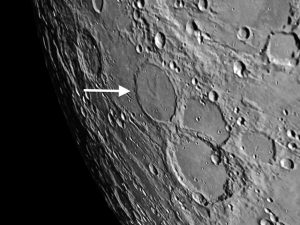The week of Feb. 12-18 takes us from Day 26 to Day 3. On Monday the Moon doesn’t rise until around 5:00 a.m. During the week, the Sun rises close to 7:00 a.m. and nautical dawn begins around 6:00, so there’s a very narrow viewing window at the beginning of the week.
 This week we will highlight the craters Wargentin, Nasmyth, and Phocylides viewable on Monday morning before sunrise.
This week we will highlight the craters Wargentin, Nasmyth, and Phocylides viewable on Monday morning before sunrise.
Wargentin: [SW/P4] This is one of the more unusual craters on the Moon. When you catch Wargentin in the right light (and Monday morning should be good), it has a fascinating story to tell. There is an almost inviolable rule that crater floors must be lower than their surrounding terrain. Not so with Wargentin! Unlike most crater impacts that leave obvious depressions, the projectile that created Wargentin blasted out a large hole, then opened up cracks that pierced through to the molten zone far below. Subsequently, hot lava rose through these fissures, filled Wargentin’s empty bowl to the brim, then inexplicably stopped just before spilling over!
If the Sun is at a low enough angle, the wrinkle ridge pattern on the surface of Wargentin looks as if an enormous chicken stamped its foot on the ground and flew off just as the lava congealed, leaving its imprint to tantalize the imagination of future astronomers.
Nasmyth/Phocylides: [SW/P-Q4] While you’re in the neighborhood of Wargentin, take a look at its two neighbors to the south, Nasmyth and Phocylides (nayz’ myth; foh-sil’-ih-deez). Under the right lighting conditions they look remarkably like a boot print (probably in hot pursuit of the chicken that just flew off from Wargentin).
OF ADDITIONAL INTEREST IN SPACE THE WEEK OF FEBRUARY 12-18:
If you hustle, you’ll just have enough time to fly to Antarctica to catch the solar eclipse on Thursday.
======================
It is highly recommended that you get a copy of Sky and Telescope’s Field Map of the Moon, the very finest Moon map available for use at the telescope. It is available for $10.95 at www.skyandtelescope.com and on Amazon. All features mentioned in this blog will be keyed to the grid on the Field Map and will look like this: Plato: [NW/D9]
Credits:
Courtesy of Gray Photography of Corpus Christi, Texas
Lunar photos: NASA / USGS / BMDO / LROC / ASU / DLR / LOLA / Moon Globe. Used by permission
- Rupes Cauchy: A Best Known Fault on the Moon - July 22, 2024
- Moon Crater Schickard – Crater Floor has Stripes - July 15, 2024
- Moon Craters Langrenus and Vandelinus - July 8, 2024